Ottawa, ville bilingue / Ottawa, Bilingual City
Le Canada est un pays officiellement binational, c’est-à-dire que dans la population, deux nations sont reconnues officiellement par le gouvernement. La nation anglophone et la nation francophone. Malheureusement les Autochtones ne sont pas reconnus officiellement, donc leurs langues n’ont pas été préservées et leurs cultures ont pratiquement totalement disparu. Les francophones ont eu plus de chance et de pouvoir pour se faire reconnaître, ce qui fait en sorte que le Canada est un pays officiellement bilingue, donc il y a deux langues officielles. Ottawa étant la capitale du Canada, cette ville se doit de donner l’exemple en applicant le bilinguisme à la lettre! Voici des photos que j’ai prises à Ottawa qui prouvent que le bilinguisme n’est pas pris à la légère à Ottawa!
Canadá es un país oficialmente binacional, es decir que en la población, dos naciones son reconocidas oficialmente por el gobierno, osea la nación anglófona y la nación francófona. Desafortunadamente, los autoctonos no son reconocidos oficialmente, entonces sus idiomas y sus culturas casi han desaparecido completamente. Los francófonos han tenido más suerte y poder para luchar por sus derechos y hacerse reconocer por el gobierno. Entonces Canadá es un país bilingüe, un país que tiene dos idiomas oficiales. Siendo la capital de Canadá, Ottawa debe dar el ejemplo a todo el país respetando el bilingüismo a la letra. Vamos a ver los resultados de estas políticas.
Officially, Canada is a binational country, which means that two nations are officially recognized among the population as being part of the majority: the Anglophone nation and the Francophone one. Unfortunately, the Natives are not officially recognized as a nation, so their languages and cultures have not been well preserved which almost caused them to disapear. The French were more lucky and they had more power to defend their rights to be recognized by the federal government. So, officially, Canada is a bilingual State, a country that has two official languages. As the capital city of this country, Ottawa must give the example by applying bilinguism to the letter. Here are some photos that proves that in Ottawa, bilinguism is not taken lightly!
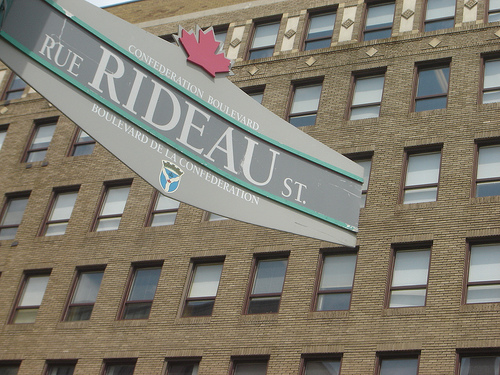
"Rue Rideau Street". Les noms des rues à Ottawa sont tous précédés du mot français "rue" et suivis du mot anglais "street".
"Rue Rideau Street". Los nombres de calle en Ottawa empiezan con la palabra francesa "rue" que significa "calle" y terminan con la palabra inglesa "street".
"Rue Rideau Street". The street names in Ottawa are all preceded by the French word "Rue" (street) and they are followed by the English word "Street".
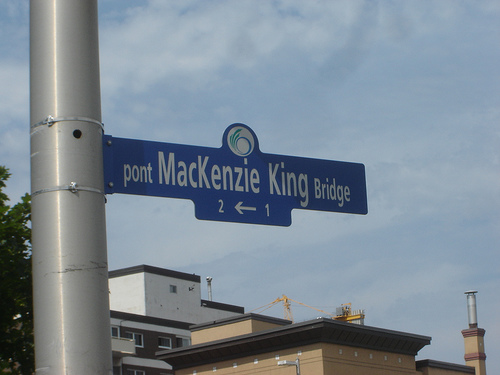
"Pont MacKenzie King Bridge". Même chose avec les ponts, les avenues, les boulevards, etc.!
"Pont MacKenzie King Bridge". Lo mismo va con los puentes, las avenidas, los bulevares, etc.!
"Pont MacKenzie King Bridge" The same goes with bridges (pont), avenues, boulevards, etc.!
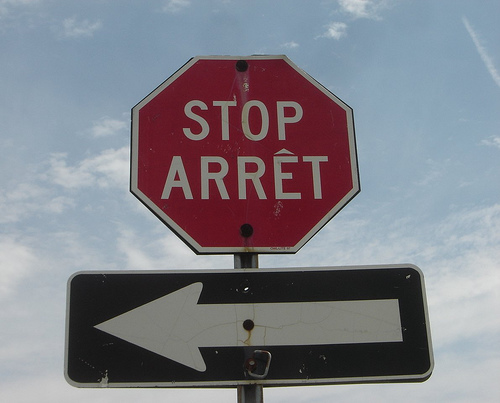
Voici ce qui est probablement le plus étonnant pour un étranger: un panneau bilingue "Stop Arrêt", probablement unique au monde, ou du moins très rare!
He aquí lo que es probablemente lo más extraño para un extranjero que visita Canadá por primera vez: un señal bilingüe "Stop Arrêt" (pare), probablemente único en el mundo, o al menos muy escaso!
Here is something that is probably very surprising for a foreigner who comes for the first time to Canada: a bilingual stop sign ("Stop Arrêt"), probably unique in the world, or at least very rare!
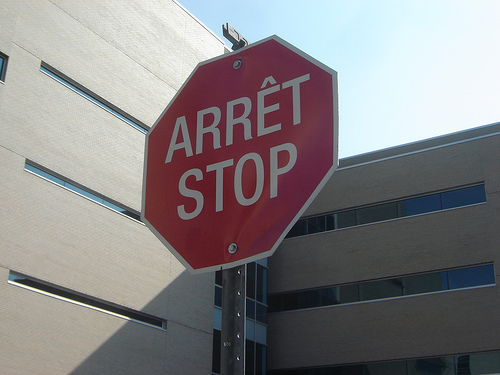
Ici, vous avez un "Arrêt Stop". L’ordre des mots est très important! La langue utilisée en premier nous informe souvent si la zone dans laquelle on se trouve est à majorité francophone ou anglophone. Dans le train que j’ai pris à destination d’Ottawa, l’opérateur prenait quelque fois le micro pour parler dans l’intercom. Il nous donnait des informations sur les conditions de la circulation sur la voie ferrée, par exemple ou bien sur une gare qui s’approchait et où on allait s’arrêter. Toutes les informations qu’il transmettait aux passagers, il le faisait dans les deux langues officielles. Quand le train se trouvait encore au Québec, il commençait en français et terminait en anglais, mais dès que nous avons passé la frontière Québec-Ontario, il a interverti l’ordre des langues et il commençait toujours par l’anglais et ensuite le français. Et ce, bien que la composition des passagers soit demeurée la même dans le train! Est-ce que l’opérateur se disait vraiment dans sa tête "nous sommes maintenant en Ontario, alors je dois parler en premier en anglais!" ou bien est-ce que tout ce changement s’est fait naturellement en lui? Je ne saurais dire, mais cette histoire illustre bien la présence des deux langues au Canada, la première langue utilisée est la plupart du temps celle de la majorité dans une province, une ville ou un quartier.
En esta foto, se ve un señal "Arrêt Stop". El orden de las palabras es muy importante! El idioma que aparece primero da, a menudo, informaciones sobre el idioma de la mayoría que vive en la zona. En el tren que tomé con destino a Ottawa, el operador usaba el micrófono para comunicar con los pasajeros. De esa forma, él daba informaciones sobre las condiciones actuales del tráfico ferroviario, o más bien nos informaba si nos estabamos acercando de una estación dónde ibamos a parar unos minutos. Todo lo que decía era en los dos idiomas oficiales. Mientras el tren se encontraba todavía en la provincia de Quebec, el operador empezaba a hablar en francés y después traducía al inglés, pero al momento que cruzamos la frontera entre las provincias de Quebec y de Ontario, él invertió el orden de los idiomas y siempre embezaba en inglés y después traducía al francés! Y eso aunque la proporción de franceses y de ingleses en el tren después de haber cruzado la frontera era la misma la de antes! No sé si el operador se decía "hum ahora estamos en Ontario, entonces tengo que hablar inglés!" o si hizo este cambio naturalmente sin pensarlo. Esta historia ejemplifica la presencia de los dos idiomas en Canadá, el primero que uno usa es el de la nación majoritaria presente en una área, sea una provincia, una ciudad o un barrio.
Here, you have an "Arrêt Stop" sign. As you see, the order of the languages was inverted. This order is very important! The language that appears first on a sign frequently gives you the information about the language spoken by the majority living in the area. In the train that I took, the operator would sometimes take the microphone to communicate with the passengers, to inform them about the traffic conditions on the track for example or to inform them that the train was arriving at a station where we would stop a few minutes. As the train was travelling through the province of Quebec, the first language that the operator would use was French and then, he would translate what he said into English. But as soon as we crossed the border with Ontario, the order changed. The operator would then talk to the passenger in English first and then translate what he said into French. I don’t know if he was thinking "now that we are in Ontario, I have to use the English language first!" or if he changed the order naturally without thinking about it. This story helps understand that the first language used in a sign or spoken by a person shows the language that is spoken by the majority living in the area.
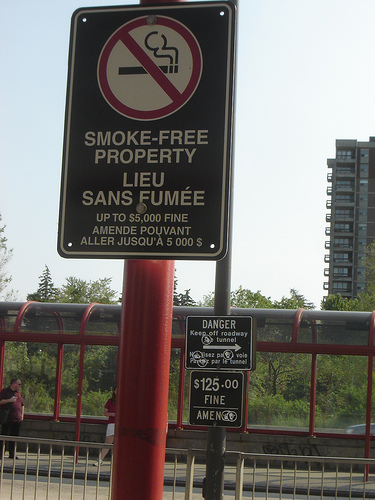
Plusieurs panneaux bilingues. Des mises en garde, des menaces d’amendes, ...
Algunos señales bilingües. Advertencias, amenazas de multas, ...
Some bilingual signs. Warnings, threats of fines, ...
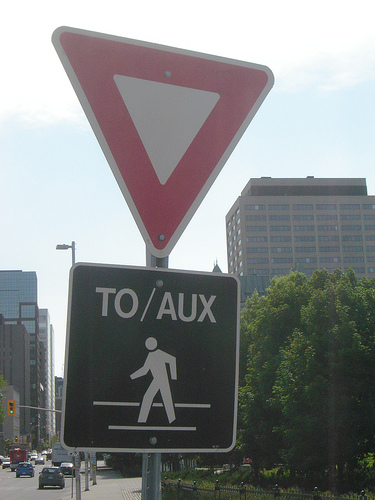
Je trouve ce panneau très intéressant. Si vous connaissez le code de la route, vous pouvez lire cette phrase. Le verbe est symbolisé par le triangle rouge et blanc et le complément est symbolisé par un pictogramme blanc sur fond noir. La préposition est écrite, dans les deux langues! Donc si vous êtes francophone, vous allez lire "Cédez le passage AUX piétons" et si vous êtes anglophone, vous allez lire "Yield TO pedestrians".
Yo encuentro este señal muy interesante. Si conocen el código de circulación, pueden leer esta frase. El verbo es simbolizado por un triángulo rojo y blanco y el complemento es simbolizado por un pictograma blanco en un fondo negro. La preposición está escrita, en ambos idiomas! Entonces un francófono leería este señal de esta manera: "Cédez le passage AUX piétons" y los anglófonos: "Yield TO Pedestrians". En español la preposición sería "A LOS" y el señal se leería así: "Ceda el paso A LOS peatones".
I think this sign is very interesting. If you know the rules of the road, you can read this sentence. The verb is symbolized by a red and white triangle and the complement, by a white pictogram on a black background. The preposition is written in both languages! So, if you are an Anglophone, you will read "Yield TO Pedestrians", while Francophones will read "Cédez le passage AUX piétons".

L’Université d’Ottawa, une université bilingue, les cours se donnent dans les deux langues.
La universidad de Ottawa, una universidad bilingüe, en cual los cursos se dan en ambos idiomas.
The University of Ottawa, a bilingual university. The courses are taught in both languages.
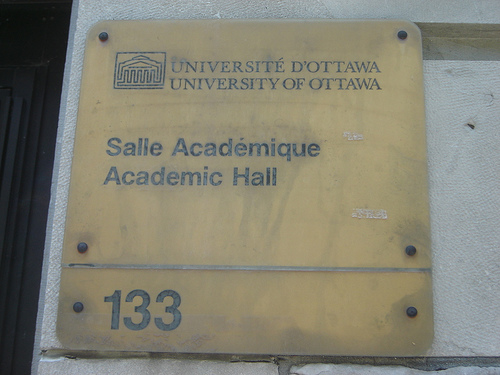
Et il semble que le français soit placé en premier dans les panneaux.
Parece que el francés está ubicado en primera posición en los señales.
It seems like on their signs, French is written first and then English.

Amende bizarre de 53,75$. Ah mais que dit ce panneau? Il est unilingue! Ils ont oublié de le traduire!
Una multa extraña de C$53,73 a cualquiera ... ah pero que dice este señal? Es unilingüe! Olvidaron de traducirlo!
A wierd fine of $53,75 if you forget to walk your bike... but how would you say that in French. The sign is unilingual! They forgot to translate it!

Eh non! Un mètre plus loin, on voit le panneau français.
Ah no! Un metro más lejos se ve la traducción francesa. (Camine al lado de su bicicleta).
Ah! No they didn’t. Three feet further you can see the French sign.
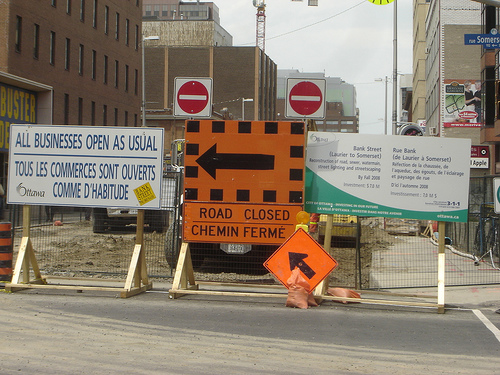
Vraiment tout est traduit à Ottawa.
Realmente todo es traducido en Ottawa.
Really everything is translated in Ottawa.
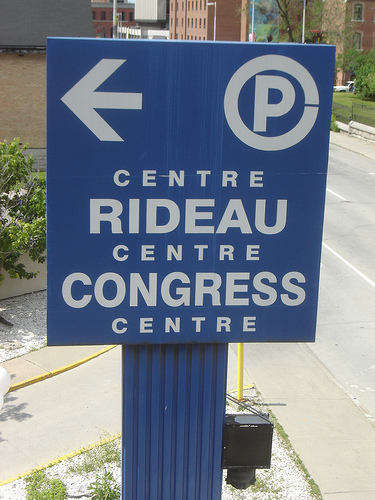
Voici un aspect intéressant des langues française et anglaise: 1/3 de tout le vocabulaire anglais est composé soit de mots d’origine française ou carrément de mots français. La plupart de ces mots ont été adoptés alors que l’aristocratie anglaise parlait le français au Royaume-Uni. Le mot "centre" est un exemple de mot français qui est passé à l’anglais. Donc, vous voyez "CENTRE rideau CENTRE congress CENTRE". Le premier "Centre" est un mot français et désigne la phrase "centre Rideau"; le deuxième "centre" est utilisé pour les deux langues (CENTRE Congress en français et Rideau CENTRE en anglais!) et finalement, le troisième "centre" est anglais et désigne "Congress CENTRE". voici une bonne façon d’économiser de l’espace et d’être bilingue!
He aquí un aspecto interesante de los idiomas francés e inglés: 1/3 de todo el vocabulario inglés es formado o sea de palabras con una origen francesa o simplemente de palabras francesas. La mayoría de estas palabras fueron agregados al inglés cuando la aristocracía inglesa hablaba el francés en el Reino Unido. La palabra "centre" (centro) es un ejemplo de palabra francesa que se integró al inglés. Entonces, ven "CENTRE rideau CENTRE congress CENTRE". El primer "Centre" es una palabra francesa y se usa en la frase "centre Rideau" (centro Rideau); el segundo "centre" es usado para los dos idiomas (CENTRE Congress, en francés y Rideau CENTRE en inglés!). Finalmente, el tercer "centre" es inglés y se usa en la frase "Congress CENTRE". Esta es una buena manera de ahorrar espacio sin perder el bilingüismo!
This is an interesting aspect of both the French and the English languages: 1/3 of all the English vocabulary is made of words of French origin or sometimes simply French words, without any modification. Most of these words were added to the English vocabulary when the British aristocracy used to speak French as their language in the United Kingdom. The word "centre" is a good example of this. On the picture, the first "centre" is French and is used in the phrase "Centre Rideau", while the second "centre" is used both in English and in French. In English, you have "Rideau CENTRE" and in French you have "CENTRE Congress". The third "centre" is exclusively English and is used in the phrase "Congress CENTRE". This is a good way of saving space on a sign without compromising bilinguism!
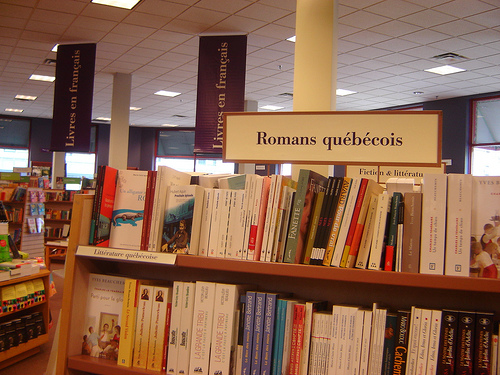
Dans les librairies, il y a une section française.
En las librerías hay una sección francesa.
In book stores, there is a French section.
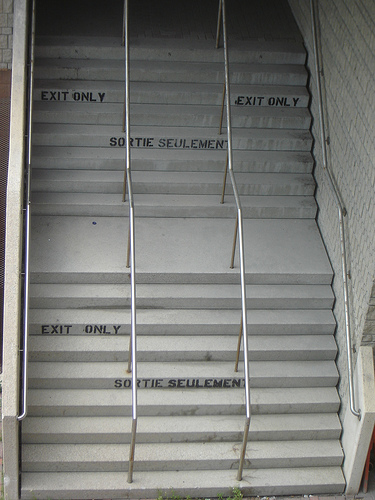
Partout, tout est traduit!
En todas partes, todo es traducido!
Everywhere, everything is translated!

Pour finir, cette image. On voit le texte bilingue "Do not enter/entrée interdite", mais plus haut, on voit une traduction d’un autre type: une conversion de système de mesure. 6 pieds / 1,8 mètres. Ceux qui ne connaissent pas encore le système métrique peuvent comprendre cette affiche grâce à la conversion en système impérial, qui était encore utilisé officiellement au Canada jusqu’aux années 1970. À l’origine, le système métrique était le système français pour les mesures et le système impérial, le système anglais. La France et l’Angleterre, les deux pays à l’origine des deux nations canadiennes, dont l’héritage est omniprésent tant dans les langues officielles que dans les deux systèmes de mesure utilisés couramment dans la langue parlée de tous les jours.
Para terminar... esta foto. Se ve el texto bilingüe "Do not enter/Entrée interdite" (no entre), pero más arriba se ve una traducción de otro tipo: una conversión de sistema de medidas. 6 pies / 1,8 metros. Los que todavía no conocen el sistema métrico pueden entender este señal gracias a la conversión al sistema imperial, que se usaba en Canadá de forma oficial hasta los años 1970. Al principio, el sistema métrico era el sistema que se usaba en Francia para medir cosas y el sistema imperial, era el que se usaba en Inglaterra. Francia e Inglaterra son los dos países que hicieron las dos naciones canadienses. Su herencia está presente tanto en los idiomas oficiales de Canadá como en los sistemas de medidas usados en el idioma hablado de todos los días.
To conclude, this picture. You see the bilingual text "Do Not Enter / Entrée interdite", and higher, you see a translation of another kind: a conversion from one measuring system to another. 6 feet / 1.8 Metres. Those who don’t know yet what 1.8 metres means can understand this sign anyway thanks to the conversion from the metric system to the imperial one, that was still in use officially in Canada until the 1970s. At first, the metric system was the measuring system in use in France and the imperial system was in use in the United Kingdom. Not only these two countries left the American continent with a legacy of both the French and the English languages, but they also brought two different measuring systems that are in use everyday in the spoken language.
5 comentarios
Boris -
Alexandre -
Gerson -
he pensado en todo esto y m he hecho una pregunta...
hay clases de idioma francés e Inglés gratis para todos los canadienses en alguna institución?
Alexandre -
Gerson -